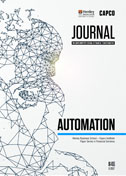Robotic process automation (RPA) is the use of software as “virtualized workforce” to operate applications like a person processing a transaction or completing a process in front of a computer screen. Currently, the logic is still mainly rule-based and robots can relieve workers to do routine process work.
In the near future, artificial intelligence will enable software robots to automate more and more work of humans with respective social and financial implications. With already over 50 providers, the market gains speed and volume, and innovation will lead to increasingly fragmented segments.
In light of related and competing automation approaches, RPA has prominent benefits and typical caveats, such as quick and predictable cost cuts and scalable near realtime service potential. They translate into elements of a potential business case. Real business scenarios suitable for RPA show that it is working.
The implementation of an RPA solution has at least three phases, the proof of concept, the pilot, and the leverage phase to other use cases within the company. If not done well, robots may be too slow, too expensive, and introduce too much complexity. A neutral partner with professional knowhow can neutralize these risks. In addition, the benefits of RPA can most probably be harvested earlier; making it right from the beginning.
Whatever you think about robots: robots and RPA are here to stay. Robots are cheap and best in data processing, consequently, they will impact the respective processes along the value chain of a lot of industries for the benefit of the company and the customer.
